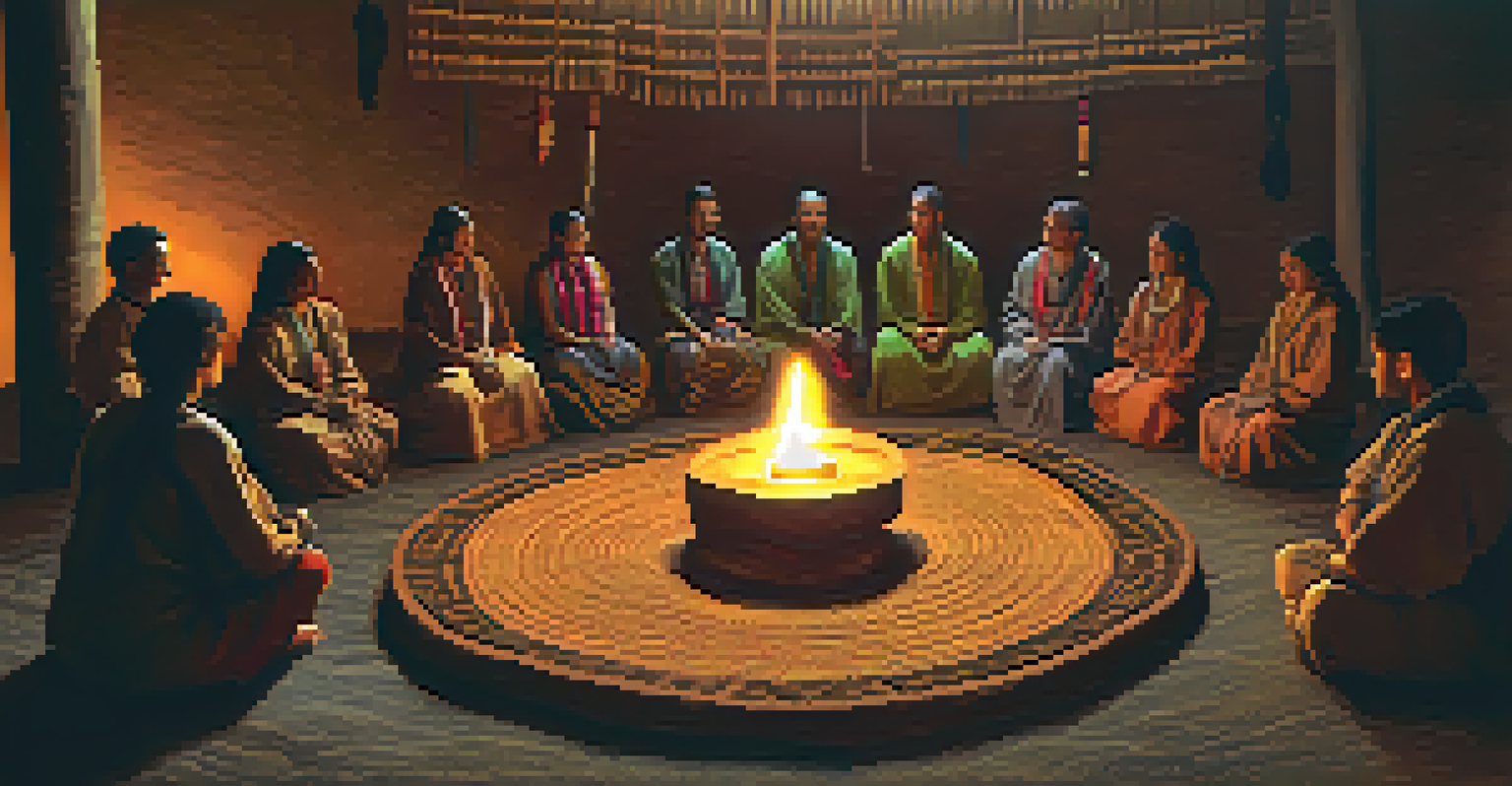The Spiritual Dimension: Ayahuasca and Reality's Nature

Understanding Ayahuasca: A Journey Beyond the Ordinary
Ayahuasca is a powerful plant medicine originating from the Amazon rainforest, traditionally used by indigenous tribes for healing and spiritual exploration. This brew combines two plants: the Banisteriopsis caapi vine and the leaves of the Psychotria viridis shrub. The result is a psychedelic experience that many describe as a journey into higher consciousness, allowing participants to explore deep aspects of their psyche and connect to the universe.
The experience of Ayahuasca is a journey inward, where we confront our deepest fears and desires, ultimately leading to profound healing and transformation.
Many people approach Ayahuasca seeking personal growth or healing from trauma. The experience often involves vivid visions, intense emotional releases, and profound insights about one’s life and purpose. It’s important to understand that while these experiences can be transformative, they can also be challenging, requiring a safe and supportive environment for participants.
The spiritual dimension of Ayahuasca lies in its ability to bridge the gap between the physical and metaphysical realms. Participants often report feeling a sense of interconnectedness with all living beings, prompting a reevaluation of their relationship with nature, themselves, and the universe.
The Role of Set and Setting in Ayahuasca Ceremonies
In the realm of psychedelics, the terms 'set' and 'setting' are crucial. 'Set' refers to the mindset of the individual, while 'setting' pertains to the physical and social environment in which the experience takes place. For Ayahuasca, having a positive mindset and a nurturing environment can significantly influence the journey, leading to more meaningful insights.

Ceremonies are often conducted by experienced shamans who guide participants through their experiences, providing a safe space for exploration. The ambiance—dim lighting, soothing music, and the presence of supportive individuals—contributes to a collective energy that can enhance the spiritual experience. This careful orchestration helps participants navigate the sometimes tumultuous waters of their inner worlds.
Ayahuasca: A Path to Healing
Ayahuasca serves as a powerful tool for personal growth and emotional healing, often leading to profound insights and a deeper connection with oneself.
When both set and setting are harmonized, the potential for deep spiritual revelations increases. Participants may emerge from the experience with a renewed sense of purpose, clarity, and a profound understanding of their existence within the cosmos.
Common Experiences: Insights and Revelations
Many who partake in Ayahuasca ceremonies report similar experiences, such as encountering a sense of unity with the universe. This can manifest as feelings of love, acceptance, and understanding that transcend ordinary perceptions. These insights often lead to a shift in perspective, encouraging individuals to embrace compassion and kindness in their daily lives.
In the heart of the Amazon, Ayahuasca is not just a drink; it is a bridge to the spirit world and a tool for awakening our true selves.
Some participants describe experiencing visions of their past, which can facilitate healing from old wounds and traumas. These powerful reflections not only help individuals confront their past but also encourage forgiveness—both towards themselves and others. The emotional catharsis that follows can be liberating, promoting a sense of peace and closure.
Additionally, many report connecting with spiritual guides or ancestors during their journeys. These encounters can offer wisdom and guidance, helping individuals navigate their life paths with greater clarity and purpose. Such experiences often reinforce the belief that there is more to existence than the physical realm.
The Science Behind Ayahuasca and Its Effects
While Ayahuasca has been used for centuries in traditional contexts, modern science is beginning to study its effects on the brain and psyche. Research has shown that the active compounds in Ayahuasca, particularly DMT (dimethyltryptamine), can promote neuroplasticity, which is the brain's ability to reorganize itself by forming new neural connections.
These changes can lead to improved emotional regulation, enhanced mood, and a greater sense of well-being. Studies also indicate that Ayahuasca may benefit individuals struggling with mental health issues such as depression and anxiety. However, it's essential to approach this medicine with respect and caution, as it is not suitable for everyone.
The Importance of Set and Setting
The mindset ('set') and environment ('setting') play crucial roles in shaping the Ayahuasca experience, enhancing its spiritual and emotional benefits.
Understanding the science behind Ayahuasca can help demystify the experience, revealing that there are tangible physiological mechanisms at play. This knowledge can also encourage more responsible use and greater acceptance of Ayahuasca in broader contexts, including therapeutic and clinical settings.
Cultural Significance: Ayahuasca in Indigenous Traditions
Ayahuasca is deeply rooted in the cultural traditions of Amazonian tribes, where it is often regarded as a sacred plant. Indigenous communities have used Ayahuasca for generations, not only for healing but also as a means to connect with the spirit world. The rituals surrounding its use are steeped in cultural significance, often involving music, chants, and communal gatherings.
The wisdom of these cultures emphasizes harmony with nature and the importance of community. For many indigenous peoples, Ayahuasca is more than just a tool for personal insight; it is a pathway to understanding the interconnectedness of all life. This cultural context enriches the experience for those who partake, reminding them of the deep roots and traditions associated with this powerful brew.
As Ayahuasca gains popularity beyond its traditional settings, it’s crucial to honor and respect its origins. Engaging with indigenous cultures and understanding their practices can lead to a more authentic and respectful approach to Ayahuasca experiences, fostering a sense of gratitude for the knowledge they provide.
Challenges and Risks: Navigating the Ayahuasca Experience
While Ayahuasca can offer profound insights, it is not without its challenges and risks. Some individuals may experience intense emotional reactions or face unresolved trauma during their journey. This can lead to feelings of fear or anxiety, making it essential to have proper support before, during, and after the experience.
Moreover, Ayahuasca is not suitable for everyone. Certain medical conditions and medications can lead to adverse interactions, making it crucial for individuals to conduct thorough research and consult healthcare professionals before participating in a ceremony. Understanding these risks can help mitigate potential harm and promote a safer experience.
Integration is Key After Ceremony
The process of integration is essential for participants to reflect on and apply the insights gained from their Ayahuasca journey to their everyday lives.
Being informed and prepared is key to navigating the complexities of an Ayahuasca journey. By understanding the potential challenges, participants can approach the experience with a balanced mindset, allowing for a more enriching and transformative process.
Integration: Applying Ayahuasca Insights to Daily Life
The journey doesn’t end once the Ayahuasca experience is over; in fact, that’s just the beginning. Integration is the process of reflecting on and applying insights gained during the ceremony to everyday life. This can involve journaling, therapy, or simply sharing experiences with others who understand the journey.
Many participants find that the lessons learned from Ayahuasca can lead to significant lifestyle changes, such as improved relationships, healthier habits, and a greater appreciation for life. This period of integration is crucial for solidifying the insights gained and ensuring they manifest in meaningful ways.

Support from community, therapists, or integration circles can be incredibly beneficial during this phase. By fostering an environment where individuals can discuss their experiences and challenges, they can reinforce their newfound perspectives, ultimately leading to a more profound transformation in their lives.